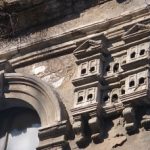Adnan Menderes Caddesi (Vatan Caddesi) carves a frenetically busy path west from Aksaray to exit Old İstanbul through the old city walls near the Ulubatlı Metro station midway between the Topkapı and Edirnekapı gates. Few people are likely to walk far along this road because of the traffic although there are a couple of monuments worth seeking out just a short way west of Aksaray.
Like London, İstanbul was once home to several lost stream and Adnan Menderes Caddesi runs above what was once the bed of the Lykos river.
North side of the road
The most striking monument along the way is the wonderful Byzantine Church of Constantine Lips that became the Molla Fenarı İsa Cami after the Conquest of Constantinople in 1453. It is one of the oldest religious structures to survive in the city, dating back in part to the z10th century, and is utterly unmissable with a single minaret rising up majestically between twin domes that surmount a red-brick structure whose multiple apses stand as reminders of frequent rebuildings. When work started in 907 the plan was for a monastic Church of Theotokos Panachrantos, the Immaculate Mother of God. Later, however, a second church dedicated to So John the Baptist was tacked onto the side. The first church had had five apses while the second went for three, using one of the existing apses to save work. Of the resulting seven apses only six still survive.
As for the peculiar name, the real-life Constantine Lips was a statesman at the courts of the emperors Leo the Wise and Constantine Porphyrogenitus.
South side of the road
On the southern side of the road the many-chimneyed Yavuz Sultan Selim Medresesi was designed by Sinan in 1549 and is now used as a medical facility. It was Sinan, too, who in 1572 designed the tomb of Yavuz Sultan Selim’s daughter, Şah Huban Kadın, that stands, largely ignored, further west beside the car park of the Migros supermarket, along with a contemporary school building.
At the Land Walls end of the road a small but important cemetery contains monuments to two very different Turkish prime ministers.
Turgut Özal (1927-93) was the much-revered statesman who started to open Turkey’s economy to the outside world in the 1980s but died a premature death that some have tried to prove was the result of poisoning (a reexamination of his remains in 2012 proved inconclusive).
Adnan Menderes (1899-1961) won Turkey’s first democratic election in 1950 but was deposed by the coup of 1960 and then hanged on İmralı island, the current prison-home of PKK leader Abdullah Öcalan. A rereading of the Menderes’ life story throws up some uncomfortable parallels with events that took place in Turkey in the 2000s.
With its almost Japanese appearance, Özal’s tomb is particularly conspicuous looming up beside the road as you race past the cemetery towards the otogar (bus terminal) at Esenler.
Transport info
To find the Church of Constantine Lips take the tram to Aksaray or the Metro to Emniyet or Aksaray. To find the cemetery take the Metro to Ulubatlı.
Nearby areas

